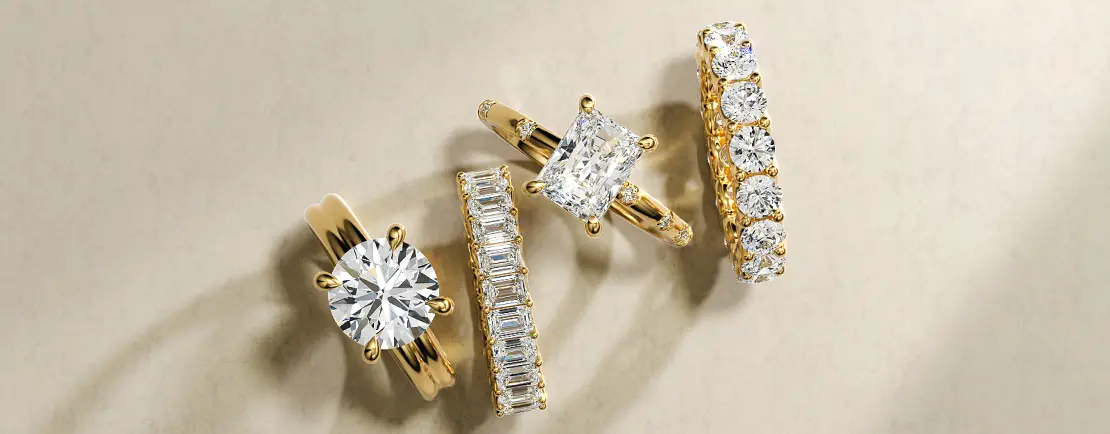What Are Conflict-Free Diamonds and Why Do They Matter?
Aug 31, 2023

In the heart of every diamond's brilliance lies a story—one of nature's magnificence and human artistry. Yet, beyond their exquisite allure, diamonds have also been entangled with tales of conflict, exploitation, and suffering.
The concept of conflict-free diamonds arises as a powerful counterpoint to this narrative, reshaping the diamond industry with values of ethical responsibility, human rights, and environmental sustainability.
From their connection to international initiatives like the Kimberley Process to the conscientious brands championing their cause, we unravel the facets of conflict-free diamonds that illuminate a path toward a more virtuous and sparkling future.
What Are Conflict-Free Diamonds?
Conflict-free diamonds are gemstones that have been sourced, processed, and traded without contributing to violence, human rights abuses, or armed conflicts. These diamonds are extracted from regions where ethical and sustainable practices are upheld, and they are free from the stain of funding conflicts that often devastate communities and entire nations.
The term "conflict-free diamonds" gained prominence in response to concerns about "blood diamonds," which are diamonds unearthed in war zones and sold to finance armed conflict against governments. To address this issue, the Kimberley Process Certification Scheme was established to bring together governments, the diamond industry, and civil society to regulate the diamond trade and prevent the flow of conflict diamonds into the market.
Diamonds that adhere to the principles of the Kimberley Process and are sourced responsibly from legitimate mines, respecting labor and environmental standards, can be certified as conflict-free. This certification assures consumers that the diamond they are purchasing not only holds the promise of exquisite beauty but also aligns with ethical values.
Brands like Yadav Diamonds and Jewelry, committed to exclusively selling conflict-free diamonds, play a crucial role in promoting transparency, sustainability, and ethical integrity within the diamond industry.
How Conflict-Free Diamonds Minimize Environmental Impact?
Conflict-free diamonds not only symbolize ethical purity and social responsibility but also shine a light on the necessity of minimizing environmental impact in the diamond industry. Traditional diamond mining practices have often been associated with ecological devastation, including deforestation, water pollution, and habitat destruction. However, conflict-free diamonds champion an alternative approach that seeks to preserve nature's glory while enhancing it with the brilliance of these precious gems.
One of the key ways conflict-free diamonds minimize environmental impact is through responsible sourcing and mining practices. Unlike their counterparts, conflict-free diamonds are extracted with meticulous care to prevent habitat disruption and soil erosion.
These responsible mining techniques prioritize the protection of local ecosystems, wildlife, and water sources, ensuring that the land retains its vitality long after the diamonds have been unearthed.
In addition, conflict-free diamonds often originate from regions that prioritize sustainable development. Many such diamond-producing areas implement reforestation programs, invest in renewable energy sources, and support conservation efforts as part of their commitment to responsible mining.
This holistic approach not only safeguards the natural environment but also empowers local communities by creating lasting economic opportunities that extend beyond diamond extraction.

The journey of a conflict-free diamond from mine to market involves traceability and transparency. This ensures that every step of the supply chain adheres to environmentally conscious practices, minimizing carbon footprints and reducing waste. By prioritizing transparency, consumers can make informed choices that align with their environmental values, fostering a collective push toward a more sustainable future.
In essence, conflict-free diamonds serve as a beacon of hope, demonstrating that the beauty of nature can be preserved in tandem with human aspirations. By embracing environmentally friendly practices, these diamonds not only contribute to the conservation of delicate ecosystems but also set a precedent for industries worldwide.
As the demand for ethically sourced and ecologically responsible products continues to grow, conflict-free diamonds stand as a testament to the harmonious coexistence of luxury, beauty, and environmental stewardship.
The Importance of Adherence to the Kimberley Process
Adhering to the principles of the Kimberley Process is a pivotal commitment that underscores the integrity and ethical foundation of the diamond trade. The Kimberley Process Certification Scheme emerged as a collaborative international initiative aimed at eradicating the trade in conflict diamonds, which have fueled violence and human rights abuses in several regions. This process sets forth a comprehensive framework that ensures diamonds are sourced from legitimate, conflict-free zones, instilling confidence in consumers and promoting global peace.
The Kimberley Process operates on the principle of traceability, requiring that diamonds be accompanied by a certification that verifies their origin. This certification acts as a passport, guaranteeing that the diamond has been procured through legitimate channels that prioritize responsible mining practices and respect for human rights.
By preventing the entry of conflict diamonds into the global supply chain, the Kimberley Process not only safeguards the ethical purity of diamonds but also contributes to the stabilization of regions that have historically been marred by violence.

Companies like Yadav Diamonds and Jewelry, which exclusively sell conflict-free diamonds, stand as models of the Kimberley Process's principles. Their commitment to sourcing and selling diamonds that have been ethically procured underscores their dedication to responsible commerce and upholding human rights.
By participating in the Kimberley Process, these companies become agents of positive change in an industry that was once tarnished by the exploitation of vulnerable communities.
In an era of conscious consumerism, adherence to the Kimberley Process principles resonates deeply with individuals who seek to make informed choices aligned with their values. This commitment transcends the transactional realm of diamonds and echoes a broader sentiment of accountability, transparency, and the pursuit of a more equitable world.
Final Thoughts
In the world of conflict-free diamonds, beauty finds its true essence when combined with ethics. As we trace the journey from mines free of violence to conscientious brands, like Yadav Diamonds and Jewelry, a powerful narrative of responsible sourcing, environmental mindfulness, and adherence to the Kimberley Process unfolds.
These diamonds are more than mere gemstones; they embody a commitment to humanity, sustainability, and a world where the brilliance they exude reflects not just light, but also the collective aspiration for a better, more harmonious future.





















